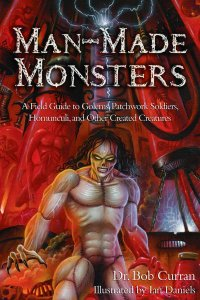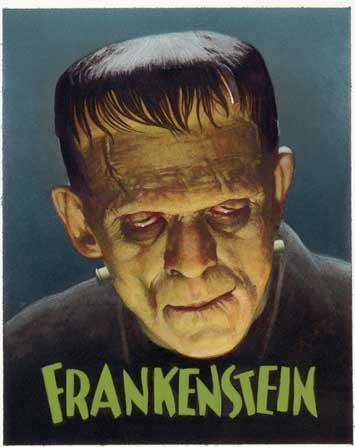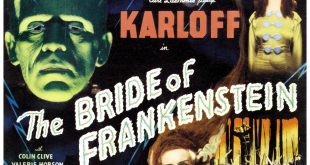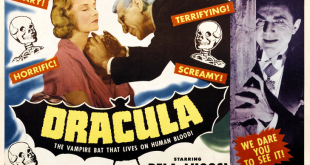Dr. Bob Curran (author)
Man-Made Monsters: A field guide to Golems, Patchwork Soldiers, Homunculi, and other created creatures.
1. Were there real events that inspired to story of Frankenstein?
The best-known of all the Man-Made Monsters is probably Frankenstein, mainly due to Mary Shelley’s famous novel. This is a being created out of the remnants of the dead and brought to a semblance of life by electrical current. However, we have to remember that Frankenstein is actually the name of its creator, the scientist Victor Frankenstein, and there have been a number of actual people who might have actually inspired this character through what might be seen as unorthodox experiments. The most famous was the celebrated Italian, Giovanni Aldini who was the nephew of the scientist Luigi Galvani and a scientist in his own right. He set out to prove his uncle’s theories about naturally produced electricity and the hypothesis that, even when a body was officially dead, it might be “kick started” by an electric shock.
His experiments with electricity rapidly became the talk of London – where he conducted many of them – and his most famous experiment with the executed George Foster was perhaps the climax of his rather bizarre career. There is, I think, no way that Mary Shelley couldn’t have known about him and he may well have served as the template for Victor Frankenstein. Of course there was a real and highly mysterious Frankenstein working in Germany around the late 1600s. This was Johann Conrad Dippel who was descended from the Frankenstein lineage and although he was primarily a radical theologian, he also dabbled in odd scientific experiments and was branded a warlock and evil mystic. Indeed, he was said to have created a potion which could make him live forever and restore the dead to life – this of course is just folklore. His reputation was still to the fore when Mary Shelley travelled across Germany with her husband and Lord Byron and he too may also have served as an origin for the tormented Victor. Mary is thought to have visited the ruined Castle Frankenstein at Darmstadt, whilst travelling up the Rhine, where Dippel was born and lived and was said to have secret laboratory. Certainly he may have given the book its name. There were many strands in the Frankenstein myth and in the book I try to tease at least some of them out. It is a fascinating story.
2. How many doctors or scientists have actually tried to bring the dead back to life?
During the late 18th and early 19th centuries, wars raged all over Europe, resulting in a fearsome loss of life. A number of conflicts were fought at sea with many sailors being drowned and the naval authorities believed that if some of the bodies could be recovered they might somehow be brought back to life and thus be available to return to the battle. Indeed one of those bodies whom Aldini approached was the English Navy with the proposal that he could revivify drowned sailors. It was not so preposterous a claim at it first appeared – a prominent London physician Dr. Henry Cline had successfully “resurrected” a mariner who had lain in a coma for several months and who was to all intents and purposes “dead”. Several other English doctors around this time were said to have attempted such “resurrections” and were believed to have experimented with Galvanic Electricity – one of these being Sir Joseph Banks, President of the Royal Society of Surgeons. The London-based Italian scientist Tiberio Cavallo is also said to have conducted such experiments with “modest results” but even he achieved nothing like the fame and notoriety of Giovanni Aldini. Even so, Mary Shelley would have been aware of such experiments which doubtless influenced her famous novel
3.When sitting down to write a book like this, where does your research begin?
If you could see where I’m sitting right now, writing the answers to these questions you’d realise that I have quite an extensive library. This has been built up across the years as I’ve always had a bit of an interest in the quirky and bizarre. So when the publishers contact me with suggestions for books, I have a fairly sound starting base. As well as that I have travelled a bit and have a number of box-files of notes that I’ve taken here and there on various subjects through talking to certain people and visiting certain sites and I also have some recordings of conversations that I’ve taken which I can listen to again. So once again I can go through that. So I look at plenty of resources before I even begin to work – books, tapes and Internet . But I usually take a couple of weeks gathering material together and plotting out books – I usually have to send off an outline of what I’m thinking about to the publishers themselves for their approval. So both the structure and a timetable are the first things I do when writing any book. Later, there are visits to places and so forth but this is really when the work begins. Boring isn’t it, but essential?
4. In what area of the world is the idea of the Man – Made Monster most popular?
I don’t think that there is any one specific area of the world where the idea of a man-made monster is any more popular than any other. The reason for this is that the concept addresses a question which is very fundamental to humans as a whole – what would it be like if we could make living creatures? What would they be like if we could? The common consensus seemed to suggest that whatever we created would be less than perfect, since perfection was the prerogative of a Supreme Creator. Therefore whatever humans themselves created would most probably be monstrous and perhaps uncontrollable. But, I think, the question was still there – it has both fascinated us and repelled us at the same time – and it has filtered into our mythology and into our literature. Thus we find ideas and stories regarding the creation of artificial life in many branches of folklore and literature all over the world.
5. What or who is a Golem?
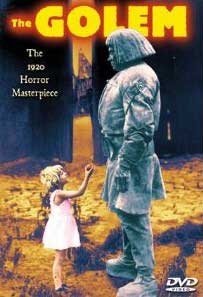 The Golem is a humanoid creature from Jewish folklore. In the Hebrew tradition, God had created a creature called Adam Kadmon which was the prototype of Adam from whom the human race is descended. The formula for creating a similar creature – which was of course imperfect – was passed down to certain holy rabbis who could give life to a figure made of clay which was known as a Golem. This being was almost shapeless and had little intelligence – it was less that perfect. However it could be controlled by the rabbi, who had created it, provided he was pure in heart. The formula for creating the Golem was extremely complex and was largely concerned with preparation and ritual. It was laid out in a mystical book which supposedly traced its origins to the writings of Abraham and was called the Sefer Yetzirah.
The Golem is a humanoid creature from Jewish folklore. In the Hebrew tradition, God had created a creature called Adam Kadmon which was the prototype of Adam from whom the human race is descended. The formula for creating a similar creature – which was of course imperfect – was passed down to certain holy rabbis who could give life to a figure made of clay which was known as a Golem. This being was almost shapeless and had little intelligence – it was less that perfect. However it could be controlled by the rabbi, who had created it, provided he was pure in heart. The formula for creating the Golem was extremely complex and was largely concerned with preparation and ritual. It was laid out in a mystical book which supposedly traced its origins to the writings of Abraham and was called the Sefer Yetzirah.
The Golem could be activated and destroyed by specific means but even though the rabbi involved was a holy person, he might still find it difficult to control the creature. The longer the Golem remained in the human world, without being destroyed, the more it began to develop a will and thoughts of its own and this made it difficult to command.
The most famous of all these creatures was the Golem of Prague which had allegedly been created by Rabbi Judah Loew ben Bezalel the Maharal of the city. It was created during a time of the persecution of Jews there by Christians under the orders of Rudolf II, King of Bohemia and Holy Roman Emperor. The Maharal created the Golem in order to peacefully protect the Jewish community but the Golem began to grow stronger and to develop a will of its own. It began to both attack and kill people in the Christian districts of Prague so that Rabbi Loew had to confront it on the steps of the Old New Synagogue in the city. There he managed to defeat it by a trick but it had grown so strong that he was unable to destroy it. He was nonetheless able to deactivate it and take its body to a geniza where it is still said to remain today. The Chief Rabbi for the District of Prague, Karel Sidon, claims to be regularly inundated with requests to visit the geniza to see the Golem – requests which he always denies.
6. What is the Philosopher’s Stone and the Emerald Tablet?
Both the Philosopher’s Stone and the Emerald Tablet were the ultimate goals of the medieval alchemists. Alchemy was, of course, the forerunner of modern science – more specifically chemistry. The Philosopher’s Stone was an element which turned base metals such as iron into gold – thus making its discoverer a wealthy person. One of the most famous of those who searched for it was Nicholas Flamel <1330-1418> who is probably better known through the Harry Potter movies. The Emerald Tablet was slightly different – it was an element grains of which could be consumed in wine and which would grant an increased lifespan to whoever
drank it. It was said that perhaps a number of alchemists had discovered this and consequently lived beyond their allotted span. One of those was said to be the Comte de St. Germain who was supposed to have lived for hundreds of years. Whether or not these
elements were ever discovered is open to question but there were stories and legends about them and about the benefits which they conferred. It’s a fascinating history.
7. What are the earliest incarnations of robots?
Today we think of robots, computers and automatons as more or less futuristic mechanisms whereas in fact they are much older than this. In fact in the early 190 0s an ancient computer, dating from Roman times was discovered on the sunken wreck of a ship off the coast of the island of Antikytherea in the Greek archipelago. This was in use long before the birth of Christ and may have been a defensive mechanism which had been captured by the Roman general Marcus Claudius Marcellus who was transporting it back to Rome when his vessel was wrecked on the Antikyterian coast.
The Mechanism itself may well have been designed by the Greek mathematician Archimedes and may have been one of several such devices used in the ancient world. It is also thought that some of the ancient Chinese designed vehicles which were guided by computers and which were used in quarries for crusting rocks. These were known as “dragons” may have given rise, in part, to some of the myths concerning the creatures. There legends of the Chi-Yu which lived in the “inhospitable mountains” which probably refer to such a device, although no trace of it has been found and the stories concerning it are impossible to date.
As far as robots are concerned there are legends concerning Thalos, a gigantic “man of bronze” who protected the island of Crete against invasion. He was said to be kept alive by a “black blood” which flowed in his veins and which was held in by a stopper in his heel. This stopper, invaders managed to pull out and his “vital fluid” drained away, leaving him weak and defenceless. And littered across history there are legends of mechanical men who either performed for or defended rulers and nobles. One of the most famous creators of automated beings was a Frenchman Jacques de Vaucanson, born in Grenoble in 1709. It was he who risked the wrath of the Church against his works and who created what many considered to be one of the finest automatons ever made – “The Flute Player” – not for military purposes but for entertainment. It is only with Capek’s writings that his “robots” were thought of in work and in militaristic terms. Although they may seem rather futuristic, robots and computers have been around far longer than we might think.
8. We’ve heard of cloning sheep, but how far away are we from cloning humans?
As you quite rightly point out, the most famous of all “cloned” creatures is a sheep named Dolly . There are also reports that both rats and frogs have been successfully cloned. However, none of these have actually been perfect, even Dolly was subject to illnesses and weaknesses which would not have characterised an ordinary sheep. But are we any nearer cloning a human being. There are those who say that we may be and I’ve read some reports that the U.S. military are currently experimenting with a type of “supersoldier” who cannot feel pain. There are some reports who say this has already been done but as yet no evidence for these assertions has been provided. At this moment in time, the idea of producing human clones remains no more than a speculation within the realms of science fiction. But is it true – maybe in a laboratory somewhere in the world, someone is creating human clones. If they are, they are keeping it a very great secret.
9. Do you have a favorite myth or legend of a Man – Made Monster?
That’s a difficult question. All the Man-Made Monsters intrigue me and I am always drawn to find out their origins. I suppose ever since I was very young I have been intrigued by the legend of Frankenstein – mainly because I remember many of the old black and white movies featuring Boris Karloff and this was part of my growing up. But I am also interested in the legend of Thalos, mainly due to a magnificent illustration done for the book by Ian Daniels . But please don’t ask me to pick because I can’t. They all interest me in different ways.
10. What will Dr. Bob Curran be working on next???
Another good question. I’ve written over five books this year and I would like to have a rest. However, that may not be altogether possible. I’ve been going back to one of my earlier interests and doing a bit of comics scripting . Nothing big though but a couple of ideas myself and some others have been playing around with Watch this space.. On the book front we’re talking over several ideas for the New Year with New Page and I’m designing a few books for a couple of other companies. One thing you can be sure of, there’ll be another couple of books coming out next year with my name on them. Right now, I’m getting ready for Christmas and to put my feet up for a few days.
 Horror News | HNN Official Site | Horror Movies,Trailers, Reviews
Horror News | HNN Official Site | Horror Movies,Trailers, Reviews
